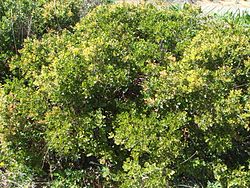| Kermes oak | |
|---|---|
 | |
| Scientific classification | |
| Kingdom: | Plantae |
| Clade: | Tracheophytes |
| Clade: | Angiosperms |
| Clade: | Eudicots |
| Clade: | Rosids |
| Order: | Fagales |
| Family: | Fagaceae |
| Genus: | Quercus |
| Subgenus: | Quercus subg. Cerris |
| Section: | Quercus sect. Ilex |
| Species: | Q. coccifera |
| Binomial name | |
| Quercus coccifera | |
 | |
| Distribution map | |
| Synonyms [2] | |
List
| |
Quercus coccifera, the kermes oak or commonly known as Palestine oak, [3] is an oak shrub or tree in section Ilex of the genus. [4] It has many synonyms, including Quercus calliprinos. [2] It is native to the Mediterranean region and Northern African Maghreb, south to north from Morocco to France and west to east from Portugal to Cyprus and Turkey, crossing Spain, Italy, Libya, the Balkans, and Greece, including Crete. The Kermes oak was historically important as the food plant of Kermes scale insects, from which a red dye called crimson was obtained. [5] The etymology of the specific name coccifera is related to the production of red cochineal (crimson) dye and derived from Latin coccum which was from Greek κόκκος, the kermes insect. The Latin -fera means 'bearer'. [6]








